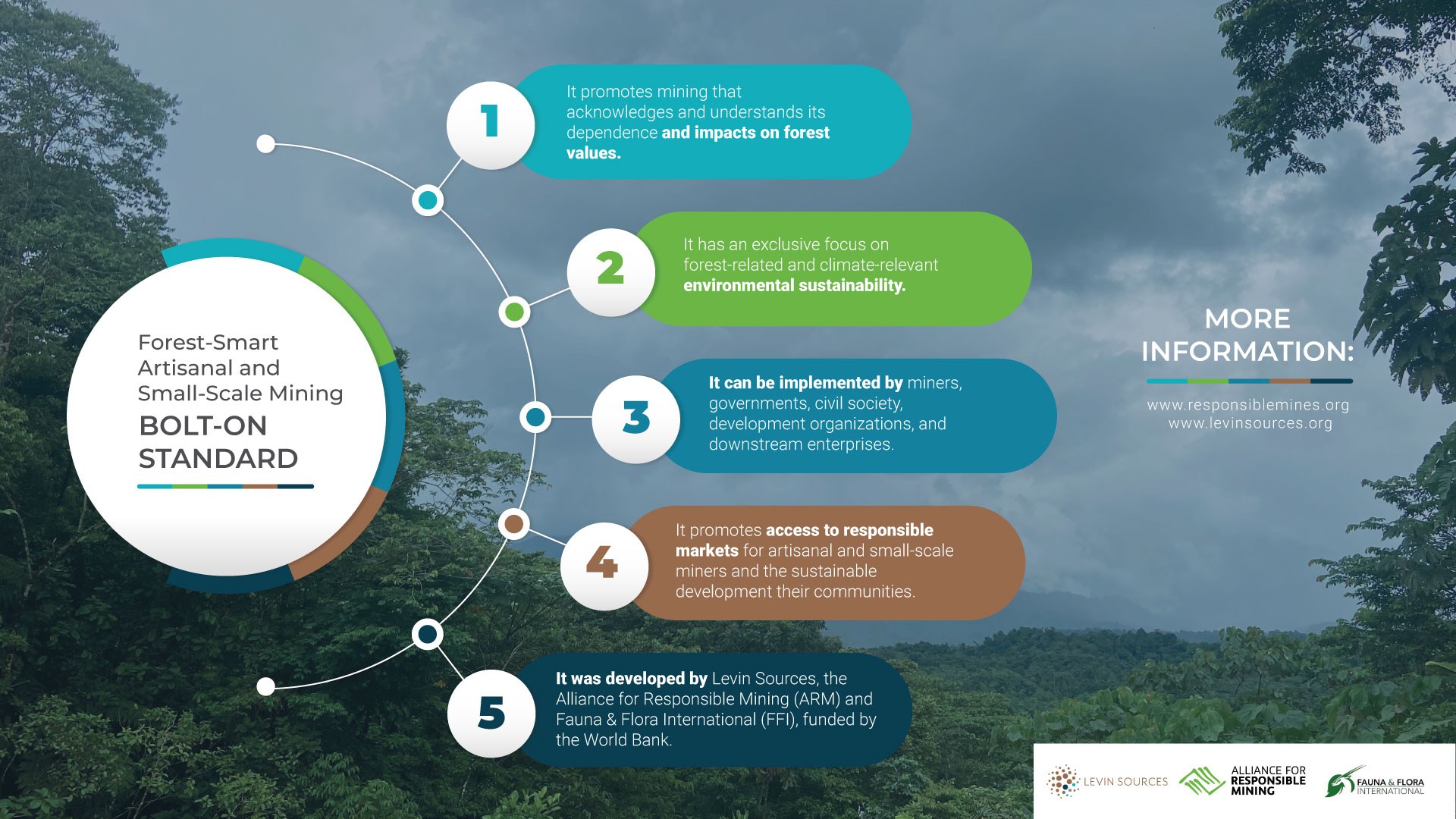The Forest-Smart Artisanal and Small-Scale Mining (FS-ASM) Bolt-on Standard (the Bolt-on Standard) is now available for use by artisanal and small-scale miners, their state regulators, and their customers.
We invite governments, civil society, downstream enterprises, and development organizations to learn more about how they can implement the Bolt-on Standard and support its development, as an opportunity to contribute to climate action and the development of the artisanal and small-scale mining (ASM) sector.
Mining is the second biggest driver of deforestation and a significant contributor to climate change. By following the Bolt-on Standard in forested areas, miners located in or within a 5km buffer zone of forest landscape will improve the environmental and human rights performance of their activities and so generate positive outcomes for forests, local communities, forest values (e.g. purity of air and water, carbon sequestration, heating limitation, precipitation cycles, etc.) and planetary health.
The FS-ASM Bolt-on Standard is a voluntary standard whose principles, criteria and indicators can either supplement or be integrated into active mainstream ASM standards or legal frameworks. It could also be used to bring a natured-based solution and mining dimension into existing carbon standards. It is designed to be flexible and adaptable to maximise adoption and expedite progress towards forest-smart mining.

The Bolt-on Standard was developed as part of the World Bank-funded project on Developing Forest Smart Artisanal and Small-scale Mining standards by Levin Sources, the Alliance for Responsible Mining (ARM) and Fauna & Flora International (FFI). We designed it in close collaboration with a Global Advisory Panel comprising standard setters, international NGOs and multistakeholder initiatives.
Our consortium and its partners are now looking for further funding for targeted, high-impact initiatives that can help the world’s ASM community successfully cohabitate with forest ecosystems.
Find out more about FSM, good and bad practices in FSM, what institutional donors can do to advance FSM, and the origins of Climate-Smart Mining (World Bank Fund).
If you want to actively engage with the implementation and/or development of the Bolt-on Standard, please send us a message hello@levinsources.com.
- Access the Bolt-on Standard
- Read the report on Developing Forest-Smart Artisanal and Small-Scale Mining Standards
What is Forest Smart Mining?
Forest Smart Mining (FSM) is mining that acknowledges and understands its dependence and impacts on forest values, in the context of other land uses (e.g. agriculture, forestry, fishing, provision of clean water, etc.), actively seeks to reduce loss or damage to those uses, and in some cases, promote a net gain for them. The World Bank conceived Forest-Smart Mining as part of its Climate Smart Mining Initiative, which was launched in May 2019. Forest-Smart Mining is becoming increasingly urgent, and is fortunately gaining political relevance.
Why was the Bolt-on Standard created?
Deforestation and forest degradation are the second leading cause of global warming, and forest loss depletes biodiversity, disrupts ecosystem services, and ultimately undermines the fulfillment of human rights. COP26 successfully generated renewed energy and diversion of capital into funds to protect forests. On the other hand, mining’s presence in forests is significant and growing, compounded by a high gold price, climate change pushing more people into artisanal mining, and the political and economic push to achieve a green and fair transition, which depends upon affordable access to critical raw materials (e.g Nickel, Aluminium, Iron) many of whose deposits are in forest landscapes. It is imperative that FSM is implemented across all scales of mining.
How does the FS-ASM Bolt-on Standard work?
The FS-ASM Bolt-on Standard has an exclusive focus on forest-related and climate-relevant environmental sustainability. Its global scope can be applied in forest, woodland, and savanna landscapes across boreal, temperate, subtropical, and tropical zones wherever legitimate ASM is being practiced. However, it remains applicable to other high-priority biomes as many of the criteria would promote improve environmental outcomes in wetlands or grasslands, for example. The Bolt-on Standard covers all minerals applicable to ASM.
To avoid contributing to the proliferation of standards, we built the Bolt-on Standard as an open-source bolt-on standard that avoids the duplication of social, environmental, or economic sustainability requirements already provided by mainstream ASM standards or frameworks. Organisations promoting responsible mining and sourcing standards can use the FS-ASM Bolt-on Standard as a resource to enhance their existing forest, climate and human rights requirements, preferably using an ISEAL-compliant process. Regulators can use the Bolt-on Standard as a resource to improve good governance of mineral and forest resources, and raise environmental awareness and political will amongst ASM miners and their stakeholders.
How does the Bolt-on Standard support non-ASM stakeholders with its implementation?
The FS-ASM Bolt-on Guidelines in Section C include recommendations for other stakeholders, such as government, civil society, downstream industries, and development organizations, which are beyond the direct control of ASM entities but are a necessary precondition for mining to be truly forest smart.
The guidelines are targeted at any organisation whose activities can create the enabling conditions that make the achievement of the Bolt-on Standard more feasible for ASM entities and communities given that miners are not solely responsible for how their mining impacts on forest should be managed and also because ASM is often under-capacitated and under resourced.
Has the FS-ASM Bolt-on Standard been tested?
As part of the creation of the Bolt-on Standard, we have designed feasibility studies and roadmaps for piloting it at ASM sites in five countries (Colombia, Peru, Ghana, Burkina Faso and Liberia). We identified conventional and innovative funding mechanisms, such as carbon or biodiversity finance.
National and local stakeholders were engaged through the site assessments to get their feedback early on in the process and to ensure the inclusion of priority stakeholders’ opinions in the design of the Bolt-on Standard. FS-ASM will only be sustainable once local people understand its benefits and are committed to its realisation.
How does the FS-ASM Bolt-on Standard link to REDD+ and Carbon Standards?
Forest-smart ASM, as conceived, is framed with the overarching principle aimed at safeguarding forest ecosystem values, including carbon storage and sequestration.
To obtain carbon financing for producing emission reductions/removals for use as offsets or to attract results-based payments under the United Nations Framework Convention on Climate Change (UNFCCC), a forest-smart ASM initiative would need to refer to a carbon standard/government program requirements. Where applicable, the Bolt-on Standard therefore contains criteria that explicitly aim toward conformance with carbon standards/government programs.
However, the Bolt-on Standard also considers the possibility that certain forest-smart ASM initiatives do not want to or may not need to pursue carbon finance, and/or there may be circumstances where a forest-smart ASM initiative would not create a carbon benefit against the baseline. Conformance with carbon finance–related requirements is therefore optional.
The Bolt-on Standard has been published – what's next?
Designing and publishing the Bolt-On Standard are only the first steps in this journey. As the majority of ASM in forests is done in pursuit of gold, supporting its adoption and implementation by ASGM miners and regulators is the highest priority.
As a consortium, Levin Sources, ARM and FFI have designed a plan to encourage adoption of the Bolt-on Standard. This includes building the business case for miners and standard setters, the delivery of on-demand training packages to facilitate user adoption; the development of further FSM guidance targeted at governments with ASM within their borders; the publication of good practices for ASM site rehabilitation and closure and the Pilot implementation of the FS-ASM Bolt-on Standard in Colombia, Peru, Ghana, Burkina Faso and Liberia.
To this end, the consortium is now looking for further funding for these targeted, high-impact initiatives that can make the difference between mining remaining the second biggest driver of deforestation and therefore climate change, and an industry that can successfully cohabitate with forest ecosystems.



